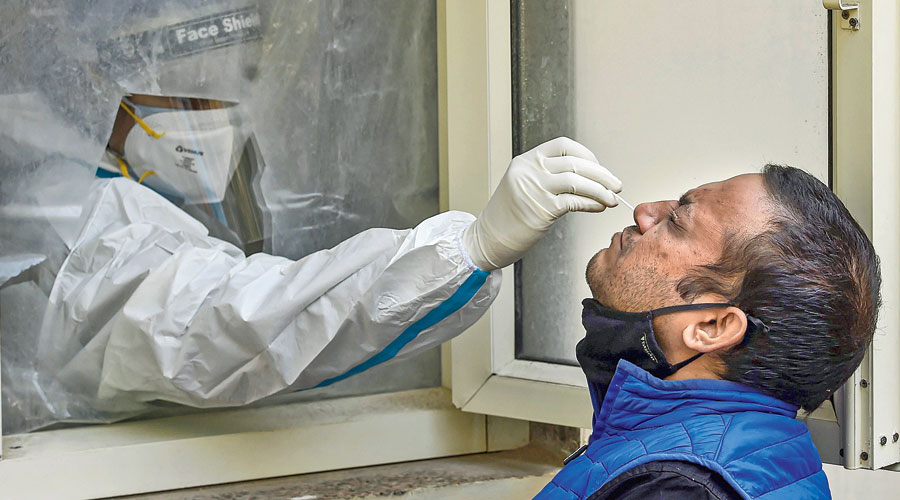A third nationwide survey has suggested that the novel coronavirus has already infected one in four people, corroborating speculation that India’s Covid-19 epidemic is shrinking as opportunities for the virus to spread are dwindling.
The survey whose findings are yet to be made public has estimated that India’s actual number of Covid-19 infections is nearly 30-fold larger than the 10.7 million lab-confirmed cases, researchers who are familiar with the findings have told The Telegraph.
A 30-fold factor would imply the number of Covid-19 infections in India has ballooned to over 320 million. The researchers declined to share details of the findings but the Indian Council of Medical Research, which conducted the survey, is expected to disclose the results within days.
The earlier two surveys had estimated 6 million infections in May and 74 million in mid-August. The second survey had predicted a doubling time of 30 days, which would mean the 74 million estimated cases in mid-August would have more than quadrupled by December. But these calculations had hinged on the then prevalent pace of the epidemic, which subsequently slowed down.
Many experts, however, believe that India’s daily new Covid-19 cases have steadily declined from a peak of around 92,000 cases in mid-September because the fraction of the population infected is approaching the herd immunity threshold — a critical value beyond which the remaining population is too small to support a continuing epidemic. An epidemic slows down as a population nears herd immunity and stops beyond that threshold.
The third survey in December and January looked for antibodies against the coronavirus in blood samples of 400 people from randomly selected households from each of the same 70 districts where the ICMR had conducted the earlier surveys in May and August.
The methodology to seek samples from the same districts has allowed researchers to track how infection prevalence rates have changed over the months — from an average of 0.73 per cent in May to 7.1 per cent in August to a higher figure in December.
Unlike earlier surveys that screened blood samples for one type of antibody against the coronavirus, the third survey looked for two types of antibodies and has estimated the average infection prevalence — on the basis of the two antibodies — to be about 25 per cent.
Independent city-based surveys have earlier suggested even higher infection prevalence levels in some urban pockets — 50 per cent in Mumbai, 60 per cent in Pune and 30 per cent in Chennai — prompting researchers to speculate India is approaching herd immunity.
Scientists had in the early months of the Covid-19 pandemic used classical infectious disease models to predict that 60 to 65 per cent of a population needs to be infected to reach the herd immunity threshold. But others have argued that heterogeneity in contacts and the individual variations in infectivity and susceptibility may reduce the herd immunity threshold to 35 to 48 per cent.
Researchers caution that herd immunity does not mean the infection will vanish. The virus will likely continue to circulate in the community, infecting susceptible persons whenever the opportunity emerges but infections will ebb to a trickle.
“The spread of the infection across India has not been uniform. There are pockets of susceptible people almost everywhere in the country and we could see some local clusters emerging here and there, but not at the scale we did a few months ago,” said a senior public health researcher.
“The vaccination campaign currently underway would play a critical role in accelerating India’s move towards the herd immunity threshold and in protecting individuals from the virus,” the expert said.
Many countries have conducted similar surveys. A global analysis of infection prevalence published in the journal Clinical Microbiology and Infection last October had noted prevalence of 5.6 per cent in England, 5.1 per cent in Spain and 4.1 per cent in the US.
A November study by the US Centers for Disease Control in the Journal of the American Medical Association had estimated overall seroprevalence across the country in mid-September to be 10 per cent, ranging from 1.1 per cent to 23 per cent in different states.
Delhi rate
The latest serological survey by the Delhi government has found that 56.13 per cent of people in the capital have antibodies to the coronavirus. The fifth such survey in the city covered 28,000 people — at least 100 from every municipal ward in Delhi. It was conducted from January 15 to 23.
Territorial health minister Satyendar Jain said: “I don’t want to get into a debate about herd immunity…. The cases have gone down considerably and have been lower than 200 for the last 10-12 days. The positivity rate is less than 1 per cent for the last one month. I want to request you to please wear a mask….”

